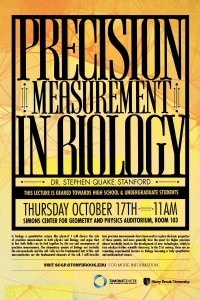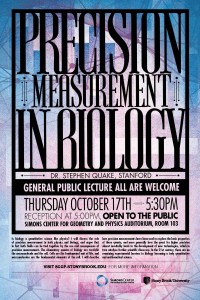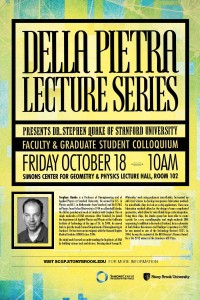On Thursday, October 17th and Friday October 18th Dr. Stephen Quake, of Stanford University, will deliver three talks for the Della Pietra Lecture Series at the Simons Center for Geometry and Physics, Stony Brook University.
Lecture 1Watch the Video
(This lecture is geared for high school and undergraduate students)
Title: “Precision Measurement in Biology” by Dr. Stephen Quake
Time: Thursday October 17th at 11:00 am
Place: Simons Center for Geometry and Physics Auditorium, room 103
Abstract:
Is biology a quantitative science like physics? I will discuss the role of precision measurement in both physics and biology, and argue that in fact both fields can be tied together by the use and consequences of precision measurement. The elementary quanta of biology are twofold: the macromolecule and the cell. Cells are the fundamental unit of life, and macromolecules are the fundamental elements of the cell. I will describe how precision measurements have been used to explore the basic properties of these quanta, and more generally how the quest for higher precision almost inevitably leads to the development of new technologies, which in turn catalyze further scientific discovery. In the 21st century, there are no remaining experimental barriers to biology becoming a truly quantitative and mathematical science.
Lecture 2 Watch the Video
(General public lecture, all are welcome)
Title: “Precision Measurement in Biology” by Dr. Stephen Quake
Time: Thursday October 17th at 5:30pm (Reception at 5:00pm, open to the public)
Place: Simons Center for Geometry and Physics Auditorium, room 103
Abstract: Is biology a quantitative science like physics? I will discuss the role of precision measurement in both physics and biology, and argue that in fact both fields can be tied together by the use and consequences of precision measurement. The elementary quanta of biology are twofold: the macromolecule and the cell. Cells are the fundamental unit of life, and macromolecules are the fundamental elements of the cell. I will describe how precision measurements have been used to explore the basic properties of these quanta, and more generally how the quest for higher precision almost inevitably leads to the development of new technologies, which in turn catalyze further scientific discovery. In the 21st century, there are no remaining experimental barriers to biology becoming a truly quantitative and mathematical science.
Title: “Precision Measurement in Biology” by Dr. Stephen Quake
Time: Friday October 18 at 10:00am
Place: SCGP Lecture Hall, 102




